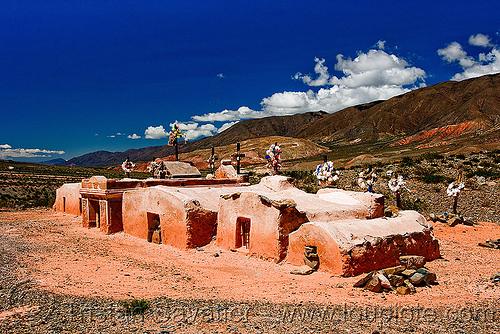Cachi, Argentina
Cachi is the capital of the departments in Cachi Salta Province in northwestern Argentina. The town has 2,189 inhabitants and is located in the Calchaquíes at an altitude of 2,280 meters. The distance to the provincial capital of Salta is 157 kilometers and 165 kilometers to the wine town of Cafayate.
Climate
Cachi has a sun -rich, dry climate. The number of sunny days varies between 340-350 a year. The precipitates are extremely low with 80 to 150 millimeters and the relative humidity is 15 percent. Temperatures vary during the summer 33-37 degrees Celsius during the day and 12 and 15 degrees Celsius at night. In winter prevail on the day a more pleasant 24 to 25 degrees Celsius and at night -6 to -10 degrees Celsius.
History
The name Cachi means in Quechua "salt". This designation would indicate that the shiny top of a nearby mountain were mistaken for a salt storage. Another interpretation attributes the word of the language of Diaguitas, the Kakana. Kak therefore would mean "stone" or "rock" and chi chin or "silence" or " loneliness ". The Nevado de Cachi is also called "Blanco Peñón de la Soledad ".
The place Cachi existed before the conquest by the Spaniards. The Diaguitas had settled at the foot of the Nevado de Cachi to use the existing mountain waters of the Rio Cachi, and the river Calchaquí through their irrigation technology in Terrace cultures for their agriculture. Because of the dryness of the climate, it was necessary to irrigate all crops. The Spaniards took over the irrigation technique of Diaguitas and expanded and improved it for their own purposes.
1673 Cachi was first mentioned. The Jesuits had established several mission stations along the Calchaquíes. When they divided the land in 1673 in encomiendas, Doña Margarita de Chavez was assigned to those areas that belonged to Cachi. 1719 Don Pascual de Elizondo was listed as land owners and later Don Felipe de Aramburu. Over time, this developed into the Finca Hacienda de Cachi, the isolated its inhabitants from the outside world and prevented an urban and economic development.
1796 was deeded to the Convento de la Merced to lease the Hacienda de Cachi by Doña Micaela L. Medina de Pomar and her nephew Juan José Aramburu. As a result, the Mercedarians build the historic Church of Cachi and share the inhabitants land, so that they build their houses near the church.
The new districts were built in the 1950s. The national government had expropriated in 1946 parts of the Finca Hacienda Cachi and released for development. These were ten acres, the west followed the presentation of the ancient village, divided into plots of 20 × 50 meters. From this period, the hospital, the school and the police buildings date.
Tourism
Cachi belongs together with the provincial capital of Salta and the idyllic wine town of Cafayate to the three main attractions of the province. The place Cachi is built in colonial architecture and surrounded by mountains in the Calchaquíes. The three-hour drive from Salta through the Quebrada de Escoipe to the Cuesta del Obispo then to rise up to 3,348 meters, is reached the highest point of the route, Piedra de Molino. The famous Recta del TinTin was already part of the 23,000 km -long Camino del Inca and continue past the National Park Los Cardone.
Among the attractions in Cachi:
- Iglesia San José ( Central Plaza ). The church was built in the 17th century in the Gothic Revival style in 1945 declared a National Monument. The Adobe walls were built on rundgeschliffenem from the water stones. Across the front rises a three-piece bell wall. Particularly noteworthy are those of Cardon ( the wood of the candelabra cactus ) crafted parts of the Church: ceiling, altar, confessional and picture frames.
- Archaeological Museum " Pío Pablo Díaz ". The museum guards around 5,000 artefacts, including a period of 10,000 years. The focus of the collection is on the period from 800 BC to 1600 AD
- La Plaza. The central square of Cachi is surrounded by a traditional stone wall, leading into the three-arched gates. The stone wall is a reminder of the meeting places of the indigenous ancestors that inhabited this region.
- Finca Palermo. A little more than 20 kilometers from Cachi find this villa, which was built at the beginning of the last century. The mansion was constructed according to the plans of the owner, Dr. Benjamin Zorrilla, a former Ambassador of Argentina in Russia, in the 1920s.
- Camino Las Ruinas Pailas. 16 km outside Cachis there is an interesting archaeological site with ruins and old mines. The place can be reached only by foot or all-terrain vehicles.
- Nevado de Cachi. The massif consists of nine Gipfelen. The highest is 6,380 meters high. Since 1950, in commemoration of the 100th anniversary of the death of General José de San Martín, she was baptized in the name of El Libertador ( The Liberator ).
Festivals
- Festival de la Tradición Calchaquí ( Third weekend in January). The Festival of Calchaquí traditions serves to rescue the customs and values of the region, their music, their dances and their kitchen.
- Fiesta in honor of San José (March 19 ). Festival with the traditional burning of Cardon ( candelabra cactus wood ).



.jpg)

.jpg)




.jpg)